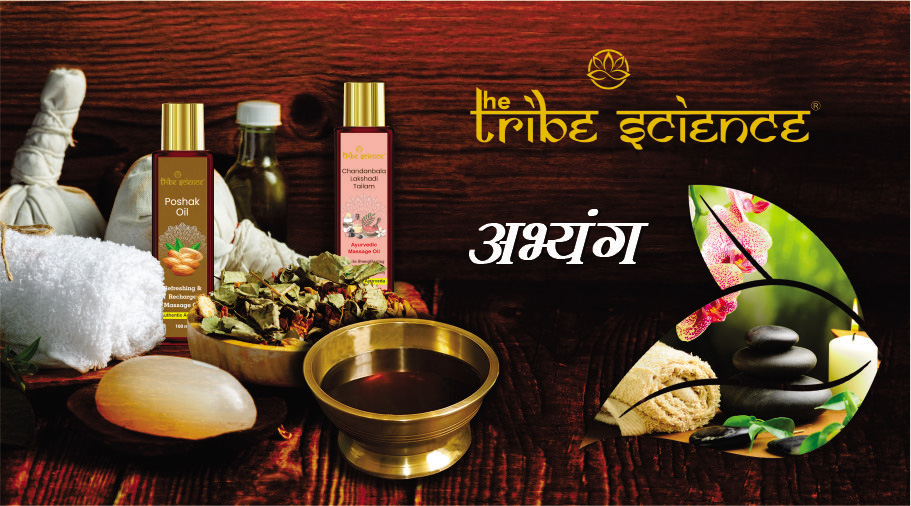नित्यं स्नेहार्द्रशिरसः शिरःशूलं न जायते| न खालित्यं न पालित्यं न केशाः प्रपतन्ति च||८१||
बलं शिरःकपालानां विशेषेणाभिवर्धते| दृढमूलाश्च दीर्घाश्च कृष्णाः केशा भवन्ति च||८२||
इन्द्रियाणि प्रसीदन्ति सुत्वग्भवति चाननम् | निद्रालाभः सुखं च स्यान्मूर्ध्नि तैलनिषेवणात्||८३||
न कर्णरोगा वातोत्था न मन्याहनुसङ्ग्रहः| नोच्चैः श्रुतिर्न बाधिर्यं स्यान्नित्यं कर्णतर्पणात्||८४||
स्नेहाभ्यङ्गाद्यथा कुम्भश्चर्म स्नेहविमर्दनात्| भवत्युपाङ्गादक्षश्च दृढः क्लेशसहो यथा||८५||
तथा शरीरमभ्यङ्गाद्दृढं सुत्वक् च जायते| प्रशान्तमारुताबाधं क्लेशव्यायामसंसहम्||८६||
स्पर्शनेऽभ्यधिको वायुः स्पर्शनं च त्वगाश्रितम्| त्वच्यश्च परमभ्यङ्गस्तस्मात्तं शीलयेन्नरः||८७||
न चाभिघाताभिहतं गात्रमभ्यङ्गसेविनः| विकारं भजतेऽत्यर्थं बलकर्मणि वा क्वचित्||८८||
सुस्पर्शोपचिताङ्गश्च बलवान् प्रियदर्शनः| भवत्यभ्यङ्गनित्यत्वान्नरोऽल्पजर एव च||८९||
One who has got his head daily well oleated alleviates head-ache, premature graying, and alopecia, while strengthening the cranial bones significantly. Hair roots become stronger, senses become clearer, the facial skin becomes smoother and the person gets sound sleep and happiness.
By filling the ears with oil daily, there will be no ear diseases of the vata type, no stiffness of the neck or jaws, no difficulty in hearing and reduced chances of deafness.
Just as a pitcher by smearing with oil, a hide by soaking in oil or an axle by lubricating with oil become firm, so does the human body when oleated with oil. The skin becomes beautiful, vata disorders are relieved, and tolerance to hardship and physical strain is enhanced. vayu predominates in the tactile sense faculty and the tactile sense faculty resides in the skin. Massage is exceedingly beneficial to the skin. Therefore, a person should practice it regularly. A person’s body accustomed to oil massage is not liable to be afflicted with injury due to external trauma or strenuous physical exertion. A person, by applying daily oil massage, becomes smooth and plump, strong and good looking, while slowing his ageing process.
“Abhayanga” word is drived from Abhi + anga,abhi meaning “into or glow” & anga meaning “limb” i.e. Taila mardana (oil massage)
Abhyanga particularly tailabhyanga has been practiced since the ancient period for maintenance of the health status and as a therapy for the morbid individuals. However its origin seems to be from ancient Indian medical science ‘Ayurveda’ A large number of traditional practices are innocuous but are widely practiced. Abhyanga is one among them. Tailabhyanga started just after cutting of umbilical cord i.e. from the starting of life.

Techniques Of Abhyanga
As ayurvedic science believes doshik involvement for diseases. Hence these important techniques has been practiced for pacification of
vitiated doshas. They are as follows.
- Active massage i.e. with strong pressure.
- Passive massage i.e. delicate stroking.
- Persuasive massage i.e. technique of pinching or kneading the small muscles between the thumb and forefinger.
Vata and Pitta conditions are treated with the combination of active and passive massage. Kaphaja vitiations are treated with active and persuasive massage.
But in infantile period is with kaphaja predominance, hence active and persuasive massage should be given as per rule, but it will be harmful
because samhita shows that in Bala period Dhatus are with Apakwa avastha, if one will give excessive of diet/medicine like adult that may
cause morbidity or mortality. So mrudu abhyanga with mild hot oil as per season should under practice.
Abhyanga technique for different areas
- Soothing rubbing movements – Legs and arms
- Pinching technique – Chest, Arms, Legs, Back
- Kneading technique – Entire body
- Pressing technique – Hard surface
- Small circular thumb movements – Only the essential Marma points of the body.
Order of massage
- Shirobhyanga
- Padabhyanga
- Abhyanga to arms and hand
- Abhyanga to abdomen and chest
- Back
- Special to hip
- Special to abdomen
For infants abhyanga with tila tail (sesame oil), Eranda Tail (Castor oil),Narikela tail(Coconut oil) and Sarsapa tail (Mustard oil) has been practiced in different localities in different seasons. However medicated oils of like Swalpchandanadi tailam,Chandanbala lakshyadi tailam, Mahalakshadi tailam etc.
Benefits
Acc,to Ayurvedic texts, it may be concluded that practice of abhyanga therapy must be life – sustaining way of manipulating the body to produce strength, moribidity, flexibility of the gross body and provides pleasure. Vagbhatta described abhyanga is one natural remedy for providing natural energy in all individuals of different age group. Vagbhatta mentioned that
- It prevents and corrects aging process (i.e.Jara)
- It helps to overcome fatigue.
- It prevents and corrects vatik vitiation
- It promotes eye sight
- Helps for nourishment of body
- Promots longevity
- Helps for good sleep
- Promotes sturdiness of the body and mind.
Marma point massaage
If you want to go deeper into your self-care routine, you can apply pressure to your marma points. Each point correlates with a particular physical and mental aspect of your mind and body. These points help us balance our energy, lymphatic, nervous, and circulatory systems.
With the following list to guide you, use your middle fingers and apply a moderate amount of pressure to each point for 30–60 seconds.
- The center of the chin (reproductive region)
- The corners of the mouth (metabolism)
- Between the nose and upper lip (cerebral circulation)
- The outer corners of the nose (sinuses)
- The center of cheekbones (lungs)
- Lower lids, just above the cheekbones (adrenals)
- The junction between the eyebrows and nose, on the lower part of the eyebrow ridge (liver/spleen)
- The temples (stress headaches and colon)
- Third eye or sixth chakra (the middle of the forehead, slightly higher than where the eyebrows meet)
- Crown of the head or crown chakra (place hands on crown of head and massage with your finger pads)
Clean it all up:
Have a luke-warm or Normal shower with a gentle, mild soap.
Pat dry your body:
Gently dry your body – instead of vigorously rubbing it – with a soft towel to make sure the moisture, softness and suppleness retains in the skin.



